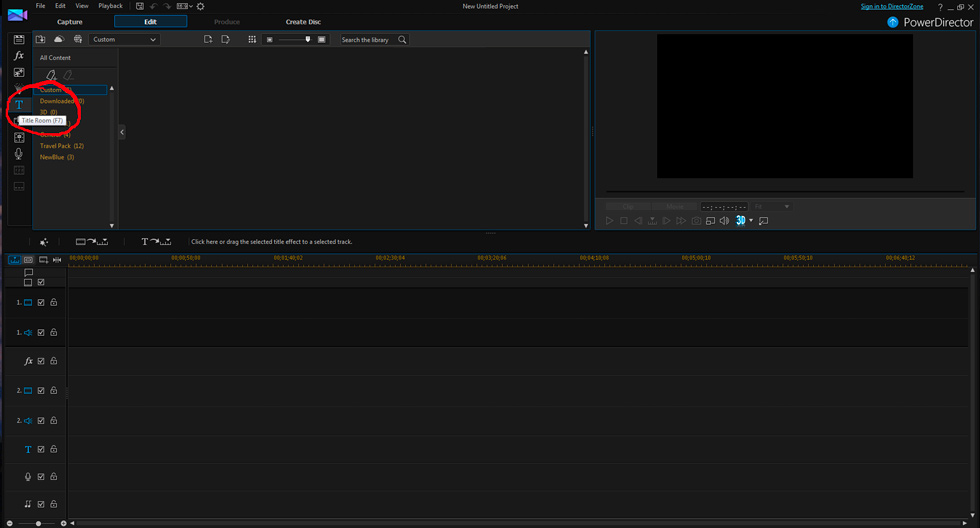
- Cyberlink powerdirector title effects update#
- Cyberlink powerdirector title effects pro#
- Cyberlink powerdirector title effects software#
Cyberlink powerdirector title effects pro#
It has often been ahead of pro products with support for new formats and new technologies.
Cyberlink powerdirector title effects software#
Even if you're not stepping into the 360-degree arena anytime soon, PowerDirector 16's video collage and advanced color-matching features make it worth the investment.“CyberLink's PowerDirector video editing software bridges the gap between professional editing and consumer-friendliness. But the app doesn't sacrifice its appeal to family shooters, as it showcases the new Collage Designer and easy-as-pie Little Planet feature. New color features elevate the app into a prosumer category for moviemakers who seek to create more artistic works. The motion- and object-tracking features offer immense control over media that can otherwise be difficult for both filmmakers and viewers. Bottom LineĬyberLink PowerDirector 16 - which might aptly be named PowerDirector 360 Edition - brings 360-degree video shooting and editing to the mainstream.
Cyberlink powerdirector title effects update#
However, one glitch I encountered in my testing was that a Windows 10 update affected critical audio functions, and I wound up having to reinstall the program to get the audio to work again. That quickness mirrors the app's responsiveness to commands throughout the interface and its overall smooth and stable operation. At 30 fps, the speed demon renderer clocked 1:02, versus the previous version's 1:58. I timed rendering at both 60 fps and 30 fps.ĬyberLink is always a fast performer, and this version's under-the-hood improvements allowed my video to race through 60-fps encoding in1:23, compared with 3:07 using the same video in the previous version of CyberLink. I combined five clips into a 2.5-minute video shot at 60 frames per second and rendered the projects to MPEG 4 at 720p. Its 64-bit Intel Core i5-5200U processor runs at 2.2 GHz on an HD Graphics 5500 system with 8GB of RAM. I tested PowerDirector on an HP Spectre x360 laptop running Windows 10 Home. As with the image stabilizer, you can accomplish this effect entirely with sliders that let you preview the effect in real time.Īudio Ducking automatically marks frames where people are speaking and lets you adjust background music to hear dialog more clearly.


The Ease In/Out option calms jerky video. You can adjust the X, Y and Z rotation to change the video's viewing angle and set key frames with a Fly In/Out feature that customizes the animated effect. PowerDirector's View Designer now supports the cool, hugely popular Little Planet projection mode, which makes it look like the subjects in your video are standing on a very small globe. While this depends on the video you use and the object you are tracking, sometimes it was hard to visualize the final product until I actually viewed it in the timeline. In the preview, the positioning is an approximation, and the previews sometimes looked odd as three objects moved through the video. A new object-tracking feature can follow objects or people in a 360-degree video and center them when converting to 16:9 2D video. The View Designer lets you incorporate 360-degree footage into standard 2D videos. You can even split the preview right in the window to compare the before and after motion, which allows plenty of tweaking for the best results.

You don't need a pilot's license, just an alert set of eyes as you move the slider back and forth to fix your wobbly footage. Under the program's Fix/Enhance menu live a variety of adjustments, including the slider-based stabilizer tool, which offers up to 120 levels of strength. MORE: Best Video-Editing Software Under $100 To that end, version 16 debuts a new algorithm that targets and corrects rotational and translational camera motion, providing even more complete 360-degree editing capabilities. Nothing induces a migraine faster than shaky VR footage right up against your eyeballs. But when it comes to stereoscopic video shot for VR headsets, the problem is amplified with motion - people biking, running, dancing, kite surfing and generally horsing around.

Video stabilization has long been critical for moviemaking, even for standard 2D output, because most nonprofessional, handheld footage is shaky.


 0 kommentar(er)
0 kommentar(er)
